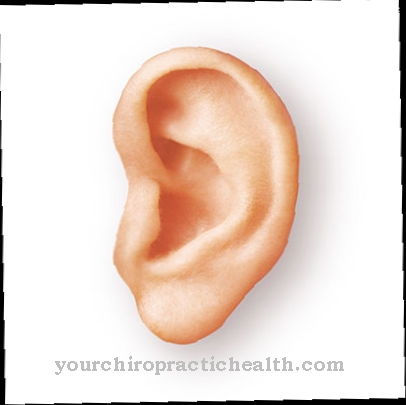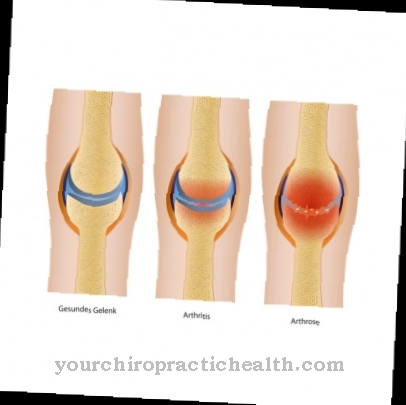The Schwartz-Bartter Syndrome is an endocrine disease that is associated with an increased release of the antidiuretic hormone (ADH). This means that too little fluid is excreted through the kidneys. The urine is insufficiently diluted.
What is Schwartz-Bartter Syndrome?

© alkov - stock.adobe.com
The Schwartz-Bartter Syndrome is also as Syndrome of inadequate ADH secretion or short as SIADH known. It is a disruption of the osmosis regulation. This malfunction is based on an increased production and release of the hormone ADH, which is also known as vasopressin.
Schwartz-Bartter syndrome is often confused with Bartter syndrome. However, this is a disease of the kidney tubules that has nothing to do with the actual Schwartz-Bartter syndrome.
causes
In more than 80 percent of the cases, the Schwartz-Bartter syndrome is based on small cell lung carcinoma. The disease appears here as a paraneoplastic syndrome. A paraneoplastic syndrome is a constellation of symptoms that occurs as part of a tumor disease, but is not a direct consequence of tumor growth.
Small cell lung cancer is a hormone-producing tumor. In the case of Schwartz-Bartter syndrome, the cancer cells produce ADH. Other causes of the syndrome are rarely found. One possible cause is the decoupling of the hypophyseal ADH control by physiological stimuli. Such stimuli can result from strokes, brain infections or traumatic brain injuries.
Schwartz-Bartter syndrome is also observed after severe burns, pneumonia or tuberculosis. In addition, it can be observed as a side effect when taking tricyclic antidepressants, serotonin reuptake inhibitors, neuroleptics, cytostatics or antiarrhythmics. It also shows that almost all patients experience a temporary increased release of ADH after an operation.
Symptoms, ailments & signs
In some cases, Schwartz-Bartter syndrome can be completely asymptomatic. Often unspecific symptoms such as nausea, vomiting, headache and loss of appetite occur. ADH ensures an increased recovery of water in the kidney. This reduces the excretion of water. This condition is known as a hypotonic hyperhydration symptom.
The retained water thins the blood, changing the concentration of electrolytes. There is a decreased level of sodium, potassium and phosphate in the blood. The result is metabolic hypochloraemic alkalosis. The severity of the symptoms depends on the dilution of the sodium. In addition to the unspecific symptoms mentioned above, personality changes can also occur.
Patients are irritable or lethargic. You seem confused. Disturbances in consciousness up to delirium or coma can occur. In addition to muscle weakness and muscle spasms, epileptic seizures or rapid involuntary muscle movements, so-called myoclonus, can occur. The neurological reflexes are increased or weakened.
The water retention is limited to three to four liters. Although this has a drastic effect on the electrolyte concentration in the blood, no water retention (edema) is visible.
Diagnosis & course of disease
If Schwartz-Bartter syndrome is suspected, various laboratory tests are carried out. Hyponatremia with a sodium concentration of less than 135 mmol / l is particularly noticeable. The osmolality of the serum is reduced overall. It is below 270 mosmol / kg. Due to the increased amount of water in the vascular system, the central venous pressure (CVP) is increased.
Central venous pressure (CVP) is the blood pressure in the right atrium and in the superior vena cava (superior vena cava). It is measured invasively via a central venous catheter (CVC) and determined with a manometer. Edema or ascites are not evident. On the other hand, there is a small volume of urine. The urine molality and specific gravity of urine are inappropriately increased. The sodium concentration is also much too high with values above 20 mmol per liter.
The determination of the ADH value in the blood has not proven to be useful. In Schwartz-Bartter syndrome, the values can be both elevated and normal.An increased ADH level in the blood is therefore not a necessary criterion for the diagnosis of Schwartz-Bartter syndrome. On the basis of the osmolality values and the amount of urine, the Schwartz-Bartter syndrome can be differentiated from other urinary concentration disorders such as diabetes insipidus centralis or diabetes insipidus renalis.
Complications
Schwartz-Bartter syndrome does not have to lead to symptoms or complications in every case. In some rare cases, the syndrome is completely without symptoms. In the other cases, however, those affected suffer from severe headaches and continue to suffer from a loss of appetite. This results in weight loss and often dehydration.
Vomiting or nausea can also occur due to illness and have a very negative effect on the everyday life of the person concerned. Most patients also suffer from a change in personality, which can lead to psychological complaints or to depression and social difficulties. The disturbances of consciousness can also lead to a coma or delirium.
This often leads to epileptic seizures, which in the worst case can lead to the death of the person concerned. The patient's reflexes are also significantly weakened due to the Schwartz-Bartter syndrome. Treatment of Schwartz-Bartter syndrome is usually symptomatic.
Those affected have to take a solution that rebalances the electrolyte balance. The other complaints are treated with medication. Whether the patient's life expectancy will be reduced cannot generally be predicted.
You can find your medication here
➔ Medicines for bladder and urinary tract healthWhen should you go to the doctor?
With Schwartz-Bartter syndrome, a visit to a doctor is definitely necessary. This disease cannot heal itself and the symptoms usually worsen if no treatment is initiated. An early diagnosis with early treatment have a very positive effect on the course of the disease and can prevent further complications. In the case of Schwartz-Bartter syndrome, a doctor should be consulted if the patient suffers from severe headaches, which are also associated with nausea and vomiting.
In many cases, a sudden loss of appetite can also indicate Schwartz-Bartter syndrome and must also be examined by a doctor. Most of those affected also show changes in their personality or severe disturbances of consciousness, which can also lead to a loss of consciousness. Epileptic seizures can also indicate Schwartz-Bartter syndrome.
First and foremost, a general practitioner can be seen in Schwartz-Bartter syndrome. However, further treatment is usually carried out by a specialist, although the further course cannot be universally predicted.
Therapy & Treatment
The therapy depends on the one hand on the clinical symptoms and on the other hand on the cause of the Schwartz-Bartter syndrome. If the diagnosis is an asymptomatic incidental finding, a restriction in the amount of drink can be sufficient therapy. However, if neurological symptoms occur, medical treatment must be given. As a rule, slow infusions with hypertonic (10 percent) or isotonic (0.9 percent) saline solution are performed.
This should compensate for the sodium deficiency. The sodium concentration in the blood should only be increased slowly. Increasing the concentration too quickly can lead to central pontine myelinolysis. It is a neurological disorder in which the covering of the nerve fibers in the area of the brain stem is damaged. The first symptoms of this disease appear half a week after the substitution.
Disturbances in consciousness, coma, increasing paralysis and swallowing disorders occur. The majority of patients recover from these symptoms, but a fatal outcome is possible. During therapy, it should be noted that hyponatremia is often also hypokalaemia. A substitution of potassium therefore also has a positive effect on the treatment of hyponatremia.
Vaptans are a newer therapeutic option. Vaptans are vasopressin antagonists. They block the action of the antidiuretic hormone on the kidney. In addition, the installation of the so-called aquaporins in the collecting ducts of the kidney is prevented. This promotes the excretion of electrolyte-free water. Tolvaptan is the only vasopressin antagonist approved in Germany.
prevention
Since the Schwartz-Bartter syndrome is usually based on other diseases, targeted prevention is not possible.
Aftercare
Since the Schwartz-Bartter syndrome is a congenital and therefore genetically determined disease, it usually cannot heal itself, so that the person concerned is always dependent on the examination and treatment by a doctor. Measures and options for follow-up care are usually significantly limited, whereby a quick diagnosis should be made in the first place in order to prevent further complaints and complications from occurring.
If the person concerned or the parents wish to have children, genetic testing and counseling should be carried out first and foremost in order to prevent this disease from occurring again. In most cases, the Schwartz-Bartter syndrome can be relieved well by the measures of physiotherapy or physiotherapy.
Those affected can do many of the exercises in their own home to prevent further symptoms and to accelerate healing. Most Schwartz-Bartter syndrome sufferers are also dependent on medication. All instructions of the doctor should be followed. The prescribed dosage and regular intake must also be observed.
Aftercare
Since the Schwartz-Bartter syndrome is a congenital and therefore genetically determined disease, it usually cannot heal itself, so that the person concerned always has to rely on the examination and treatment by a doctor. The measures and the options for follow-up care are usually significantly limited. First and foremost, a quick diagnosis should be made to prevent further symptoms and complications from occurring.
If those affected want to have children, genetic testing and counseling is recommended to prevent the disease from recurring. In most cases, the Schwartz-Bartter syndrome can be relieved well by the measures of physical therapy or physiotherapy.
The person affected can also do many of the exercises in their own home to prevent other complaints from occurring and to accelerate healing. Most of those affected by Schwartz-Bartter syndrome are also dependent on taking medication. All instructions of the doctor should be followed, and a doctor should be consulted first if there are any questions or if anything is unclear. The correct dosage and regular intake must also be observed.
You can do that yourself
Patients suffering from Schwartz-Bartter syndrome should, among other things, pay attention to the amount they drink. Depending on the exact diagnosis, it can already help if you drink less fluids.
However, related to neurological symptoms, people should see a doctor to prevent sodium deficiency or similar problems. The sodium deficiency can gradually be compensated for in close consultation with the attending physician. A good body awareness is very important in order to identify possible health disorders in good time. Therefore patients should observe themselves. Headache, lethargy or irritability, and nausea may indicate worsening. Muscular weaknesses and cramps are also possible.
A change in diet is usually not enough to counteract the sodium deficiency. It is therefore important that those affected adhere to the doctor's precise instructions. Disturbances in consciousness or confused states should not be concealed, otherwise there is a risk that the seizures will worsen. It is better to take targeted action against the symptoms and correctly interpret your own body signals. Since the disease is rare, there are hardly any self-help groups. This makes trust between patient and doctor all the more important.
























.jpg)



